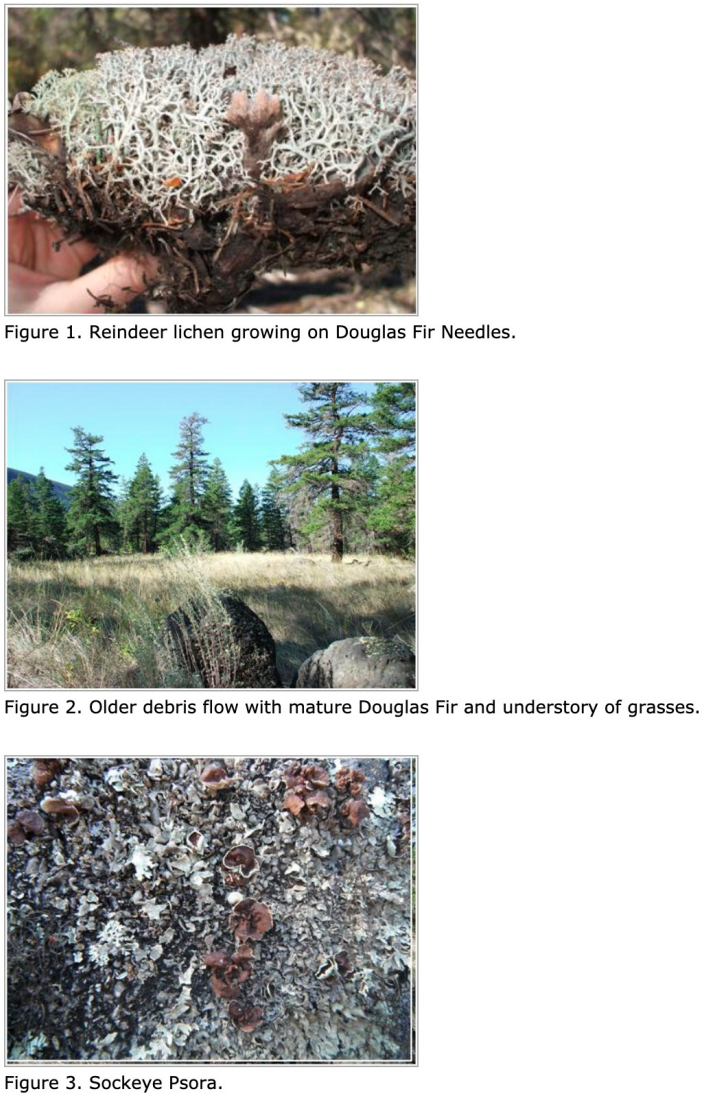The debris flows at Big Creek Confluence when initially formed were likely first colonized by lichen growing on the massive boulders and on the fine glacial material. If one was to examine the rocks in the area, a number of species can be observed. Lichens are first to colonize bare rock due their ability to obtain their own nutrients and carbohydrates. Lichen is a symbiosis between fungi and algae or cyanobacteria. The algae are able to photosynthesis, capturing energy from the sun and fixing carbon dioxide in the atmosphere into carbohydrates. Cyanobacteria are also able to convert di-nitrogen in the atmosphere into bio-reactive forms of nitrogen (ammonium NH4). The fungi provide a structure protecting the bacteria from harsh environmental conditions.
Lichens have a number of different growth forms; they can grow as a dust, crust, scale, leaf, club, shrub, or hair. Below is a list of lichen species observed at Big Creek campground on rocks, trees, and soils. The lichen in this area is specially adapted for drought conditions. Lichens and bacteria contribute to the formation of cryptogamic crusts, which form on glacial flour deposited around the boulders. This crust is known for holding together grasslands covering patches on dry terraces above the campground. The below mentioned lichen grow on small litter layer created by vegetation or on bare surface. Together they create a crunchy surface to walk upon.
(1) Ribbed cladonia (Cladonia cariosa) Scale lichen, first to colonize soil in dry forest and grasslands after a disturbance. Form overlapping colonies consisting of small to med sized scales that stand upright. The upper surface is pale grayish green to browinish green while lower surface is white and cottony.
(2) Cow pie (Diploschistes muscorum) commonly grows over ribbed cladonia acting as a parasite however later able to be free living. Grows as a continous to chinky crust lichen with whitish grey surface color.
(3) Grey Reindeer Lichen (Cladina rangiferina) med size to large upright shrub lichen 5 to 8 cm tall. Intricately branched from main stem form extensive carpets over the ground in open conifereous forests and open sites. Latin means "small branches" and "pertaining to reindeer".
Hiking along the Chilcotin, you pass through progressively older debris flows. This is indicated by both increased size of trees, increase in soil development, and the establishment of grasses that are starting to hide the size of the scattered boulders. Surface is more open with scattered rocks. In this older Douglas Fir grassland can be found a lichen named after the spawning sockeye that are running up the river below. Sockeye Psora (Psora decipens) is scale lichen that forms scattered colonies over calcium rich soil in open undisturbed grasslands. This species is slow to colonize after a disturbance and thus indicates an older section of the debris flow. The lichen forms small discrete shell like lobes (roughly 5mm) with upper surface that has a pinkish red to brownish red color, similar to the color of the spawning sockeye salmon. Near this area on river left is a large boulder of basalt, below which can be observed the spawning salmon making their way up the river. This is one of the few spots to observe the salmon in otherwise turbid waters of the Chilcotin. It is incredible to think the fish across from river left to river right through the rapids right before the confluence with Big Creek. Incredible Fish!
The following lichens grow on rocks and/or trees:
(1) Lime dust (Chrysothrix chlorina): appears as a continuous dust with bright green fluorescent greenish yellow granules. The lichen is able to obtain moisture directly from the atmosphere.
(2) Weathered Ruffle (Cetraria platyphylla) is loosely attached leaf lichen with broad lobes 4-10 mm wide. It is found on conifers in open, dry areas.
(3) Powdered Shield (Parmelia sulcata) grows on trees and rocks in forests and open sites. It is the most common, widespread, and easiest to identify. It is a leaf lichen with narrow lobes (1-3 mm) with an upper surface that is pale grayish with a lower surface that is black with several copiously branched black holdfasts.
(4) Wolf Lichen (Letharia vulpine) form bright green sulphur yellow shrub shape 4-8 cm long on conifers in open or exposed sites. Especially common in open Douglas Fir forests. Its latin name Letharia refers to the lethal toxin vulpinic acid that the lichen produces.
(5) Edible Horsehair (Bryoria fremontii) large pendent hair lichen 30 to 45 cm. Yellowish brown to reddish brown intricately branched and irregularly grooved. Found on coniferes especially in Douglas Fir and Ponderosa Pine forests.

